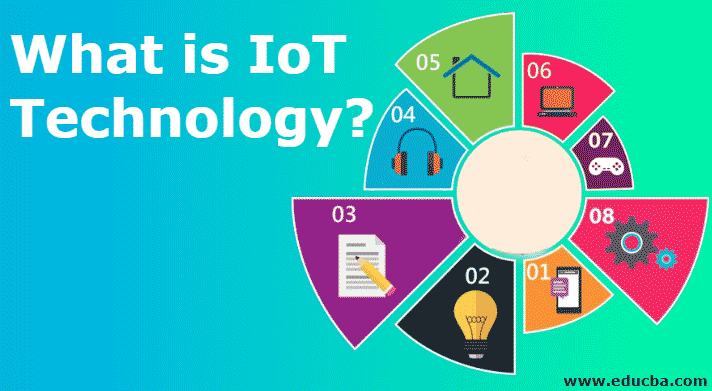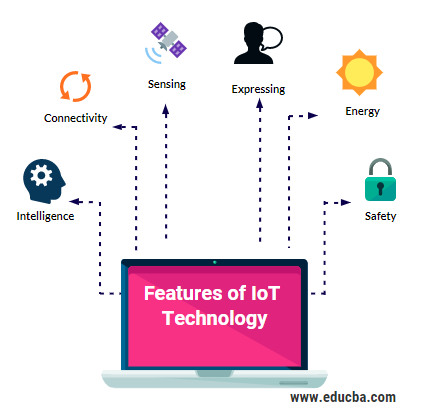Updated May 29, 2023

Introduction to IoT Technology
IoT technology can be described as the ‘Internet of Things,’ based on the concept that all the desired devices can be connected inside a specific network for sharing data and information without any manual intervention. We can segregate the devices used for this purpose based on their capability to send, receive, and gather data in the network. IoT’s salient properties include its secure nature, usability on smart devices, ability to connect to any network, and facilitation of faster connectivity.
What is IoT Technology?
- IoT is like establishing communication between interrelated computing mechanical devices that can transfer data over the internet and respond accordingly in the human-machine contact-free world. There is numerous example to show where IoT can be applicable and beneficial.
- Let’s consider a couple of them. Imagine that you had to leave early to the office and left your Air Condition on, which is quite unnecessary and, if not switched off, will consume unnecessary power throughout the day until you return.
- If the device is smart and connected to the internet, the owner can issue a command to trigger the software and switch off the device, saving lots of effort. This similar scenario can be applied to other devices as well. A oneliner for IoT will be as below.
- “Connecting all the devices in the world with the internet.”
Categories of IoT Devices
IoT has three categories based on the devices that connect over the internet.
- The devices that can collect and send the information.
- The devices that collect and respond to the information.
- The devices that can equip both of the above features.
1. The devices that can collect and send the information
One word substitute for devices that collect and send the information is ‘sensors’. Numerous sensors are available, like temperature, motion, and different quality measurement sensors, and it can be any of them or a combination of them. These sensors are intelligent and can collect information for us to decide. Like our senses like sight, taste, touch, etc, the machinery sensor will make machines feel the senses and respond.
2. The devices that collect and respond to the information
Many machines will act after receiving the information, like a printer connected to your desktop which will respond upon print request. Similarly, the signal from the car key will make your car door respond and open. There will be endless examples of such devices. If we trigger the machines with a complex or simple command and design them with a good algorithm, they will aptly respond unless the situation is extreme.
3. The devices that can equip both of the above features
The actual power of IoT is from these kinds of devices that can do both of the above-discussed features. The sensor will collect the information, and the devices intelligently should respond with the intervention of humans. Depending on the output of the moisture sensor from the soil, the irrigation system should, by default, try to operate on the motor without the involvement of the actual farmer. If we connect this irrigation system to the internet and enable it to receive weather details, it will enhance its intelligence and optimize motor actions for improved efficiency. Achieving this kind of efficiency is the target of these organizations which work on IoT.
Features of IoT Technology
The six main characteristics and features of IoT are listed below with the description.
- Intelligence: This will be essential for smart products.
- Connectivity: This feature will be responsible for network accessibility and compatibility features of the devices, hence one of the prime characteristics.
- Sensing: Like collecting the information basing the retrieval capacity and providing it for an intelligent decision.
- Expressing: This will enable interactivity with humans and the world.
- Energy: Without this, our devices will not be created. Energy harvesting and proper infrastructure to charge will be important features for our IoT devices.
- Safety: The prime feature on which customers rely and use the product. Hence, we cannot allow any compromise on this matter, and it is essential to check and validate all the details. For some features, you see, there are even government regulations.
Benefits of IoT Technology
There are many benefits of IoT technology which is a niche technology, and some of them are listed below:
1. Business Opportunity: There will be enhanced opportunities for the business with IoT, and new revenue tracks can be easily developed. IoT-driven products and innovations will be an asset to the organization.
2. Enhanced and Efficient Asset Utilisation: with IoT, there will be improved tracking of the assets, and efficient products can be achieved on a real-time basis.
3. Enhance Device Communication: Establishing the interaction between machines will be a boom, and IoT will be one step further in this process.
4. Automation and Control: IoT, with its device interaction and connectivity, strives towards achieving automation with minimal human intervention since machines can lead to the faster and more timely output.
5. Time-Saving and Efficiency: IoT, which uses the machine to machine interaction, will help us to utilize human time efficiently, and also, the work gets faster results which will define its efficiency.
Conclusion
Thus IoT is a niche technology where lots of work is going on, and organizations are trying to automate human effort so that the chance of error will be minimal or zero. IoT will make things much easier for humans and organizations with their machine-to-machine interaction and connectivity.
Recommended Articles
This is a guide to What is IoT Technology? Here we discuss the categories, features, and benefits of IoT technology. You may also look at the following articles to learn more –


